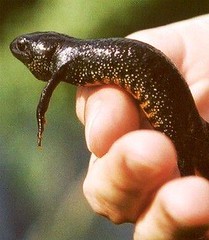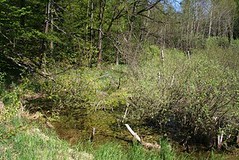
Ecology:
Triturus cristatus is a species, which needs both several aquatic habitat and also few terrestrial habitat types. Triturus cristatus can only bred in water, so it is completely dependent on water bodies.

The adult newt migrates in early spring from hibernation site to the breeding pond. The ponds chosen must have an underwater vegetation of plant with soft leaves suitable for the female to lay eggs in. Further the pond must have fairly clear water and preferably pond bottom areas without vegetation in order for the males to carry out the mating courtship towards the females. In order for the pond to a successful breeding pond there must be no fish that can easily predate the very pelagic larvae of Triturus cristatus. Further the pond must have a rich underwater vegetation mixed with open water areas and with plenty of small invertebrate pray and tadpoles that the larvae can feed on.
Some breeding ponds can be deeper and at the same time function as foraging ponds for the adult Triturus cristatus during the summer. Also juvenile one year old Triturus cristatus may enter ponds for foraging during spring and summer. Hibernation places is as we know on dryer terrestrial habitats that never floods during spring and that are frost free during winter. It can be forest, hedgerows, stone fences and stone piles and house cellars.
Triturus cristatus feed on invertebrates and their larvae both under water and on land. From July to September and very site dependent a most of the population leaves the water and seek shelter and food in terrestrial habitats rich in structure and hiding places as forest with laying dead and alive tree trunks or in cultural landscape with a mixture of meadow stone fences and hedgerows. The terrestrial habitat does not have to be sun exposed.

Population trends:
Nearly everywhere populations are declining, mainly due to anthropogenic habitat deterioration, however the species seems not quite so vulnerable as Bombina bombina in the North European lowland.
In Lithuania, Triturus cristatus is a declining and threatened species. Mostly the species is distributed in the eastern and central parts of the country.
In Poland, Triturus cristatus is a declining and threatened species. Locally its still common and some of the areas Triturus cristatus have viable populations of Triturus cristatus. However last 10 years monitoring in the agriculture landscape around Bialowieza show a few local extinctions but more stable population trends a visible in Forested areas.
In Germany, Triturus cristatus are in decline. The loss of ponds and overgrowing of ponds and intensive agriculture are the main cause.


